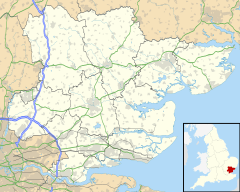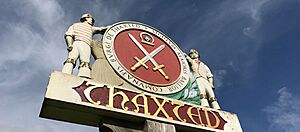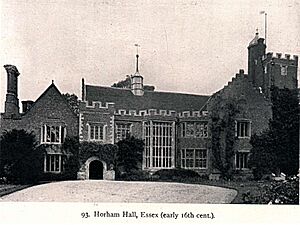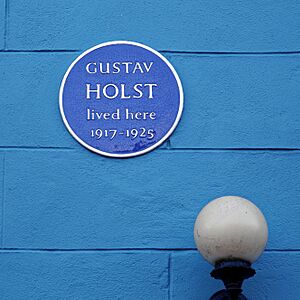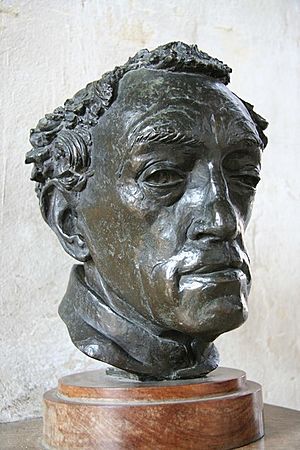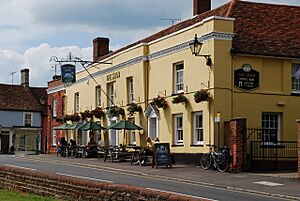Thaxted facts for kids
Quick facts for kids Thaxted |
|
|---|---|
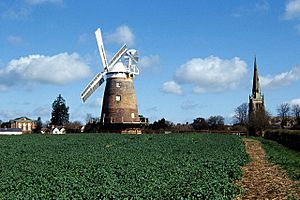 Thaxted Windmill and Church |
|
| Population | 3,116 |
| OS grid reference | TL615315 |
| Civil parish |
|
| District |
|
| Shire county | |
| Region | |
| Country | England |
| Sovereign state | United Kingdom |
| Post town | DUNMOW |
| Postcode district | CM6 |
| Dialling code | 01371 |
| Police | Essex |
| Fire | Essex |
| Ambulance | East of England |
| EU Parliament | East of England |
| UK Parliament |
|
Thaxted is a charming town in the Uttlesford area of north-west Essex, England. It sits in the valley of the River Chelmer, close to where the river begins. The town is about 97 metres (318 feet) above sea level, which is where its main church stands.
Thaxted is about 15 miles (24 km) north of Chelmsford, the county town. It is also about 5.5 miles (8.9 km) east of the M11 motorway. The area around Thaxted includes small villages like Cutlers Green, Bardfield End Green, and Monk Street. Thaxted is known as a "town" because of its important medieval guildhall and its beautiful English Perpendicular parish church. The guildhall was a place where groups of skilled workers, called guilds, managed their trades.
Contents
- Discovering Thaxted's Past
- How Thaxted is Governed Today
- Thaxted's Population Over Time
- Learning in Thaxted
- Places and Activities in Thaxted
- Thaxted's Community and Culture
- Getting Around Thaxted
- Important Buildings and Landmarks
- Thaxted and Music
- Thaxted and Morris Dancing
- Thaxted in Films
- Famous People Connected to Thaxted
- Places of Worship in Thaxted
- Thaxted's Businesses and Shops
- Images for kids
- See also
Discovering Thaxted's Past
Thaxted's name comes from old English words meaning "a place where materials for thatch are found." In the 1086 Domesday Book, it was called 'Tachesteda'. Over time, its name changed spellings many times.
Thaxted started as a Saxon village on a Roman road. There was a Roman villa nearby, and Roman objects have been found in the area. The British Museum even has a Roman bronze head of Bacchus found in Thaxted. The first written record of Thaxted, including a church, is from between 881 and 1016.
What Did Archaeologists Find in Thaxted?
In 2007, experts from Oxford Archaeology found items from the Bronze Age, Iron Age, Roman, and medieval times. These included flint pieces, tiles, pottery, ditches, and even graves. In 2015, another dig found a large medieval ditch that might have been part of the town's defenses. They also found items from the 1400s and 1500s, plus animal bones.
Thaxted in the Domesday Book
The 1086 Domesday Book shows Thaxted had 108 households. This included 54 villagers, 34 small farmers, 16 slaves, and 4 free people. The land had enough for 28.5 plough teams and included two mills, meadows, and woodlands. In 1066, the area had horses, cattle, pigs, sheep, and beehives. By 1086, the number of sheep and beehives had grown.
Thaxted's Cutlery Industry
During the Middle Ages, Thaxted became famous for making cutlery (knives and other sharp tools). The town's guildhall and its town badge, which shows two crossed swords, remind us of this. Even a nearby village is called Cutlers Green. It's a bit of a mystery why Thaxted became a cutlery center, as it didn't have the natural resources needed. However, recent digs found proof that blades were made here, not just finished.
By the early 1300s, cutlers were doing well in Thaxted. In 1310, a cutler from Thaxted even bought the right to work in London. By the 1320s, Thaxted was known for its cutlery. Records from 1381 show 79 cutlers in Thaxted, along with other related workers like smiths.
This growth in crafts changed the town. People became less dependent on farming for the local lord and more on industry. Thaxted was allowed to hold a market in 1205. Some townspeople gained more freedom from the manor, living in an area called the "borough."
Thaxted's Borough Status
Thaxted became a formal "borough" sometime in the 1400s. A charter from 1556 said Thaxted "is an ancient borough" with a mayor and other officials. This charter was meant to help the town after it had fallen into "great ruin and decay." Even though the borough status ended in 1686, people in Thaxted still call it a "town."
Guilds were important. A guild of cutlers started during the time of Edward III (1327–77). In 1481, Edward IV allowed Thaxted residents to create a "fraternity or perpetual gild" to manage themselves. The famous Guildhall is thought to have been built by the cutlers' guild.
How Thaxted is Governed Today
Thaxted has a Parish Council made up of 11 elected members. They manage local places like the Recreation Ground, the Windmill, and public car parks.
Thaxted is part of the Thaxted and the Eastons Ward for Uttlesford District Council. This ward elects two people to the district council. For Essex County Council, Thaxted is in the Thaxted Division, which also covers nearby villages. This division elects one county councillor.
In 2021, the Thaxted area had a population of 5,291 people.
Thaxted's Population Over Time
In 1829, Thaxted had 2,293 people. By 1881, this number had dropped to 1,914, and by 1921, it was 1,596. However, the population has grown since then. In 2001, it was 2,526. By 2011, it reached 2,845, and in 2021, it was 3,116.
Learning in Thaxted
Thaxted County Primary School opened in 1878. It is still in its original Victorian building and is run by Essex County Council. For high school, students in Thaxted usually go to the Helena Romanes School in Great Dunmow. There are also several preschools in the area.
In the past, the 1556 Borough Charter helped set up a grammar school in the Guildhall. This school was open from 1714 until 1878.
Places and Activities in Thaxted
Thaxted Public Library is run by Essex County Council. It also has a Community and Tourist Information Office.
The town has several places for meetings and events. The Guildhall is used for exhibitions and meetings. Bolford Street Hall and Thaxted Church Hall are also available.
Thaxted Parish Council looks after public parks and open spaces. These include the Margaret Street Garden and the Recreation Ground. There are many public footpaths for walks and hikes. The Harcamlow Way long-distance trail goes through the town.
Thaxted Surgery provides healthcare. The Thaxted Centre for the Disabled helps people with physical disabilities. Essex County Fire and Rescue Service has a fire station in Thaxted with local firefighters ready to help.
Thaxted's Community and Culture
A "village design statement" was created for Thaxted between 2007 and 2009. This document describes the town's character and helps guide future building projects. It was made with input from local residents.
The Thaxted Society is a charity that works to protect Thaxted's history and promote its future. They publish a newsletter called the Thaxted Bulletin.
The annual Thaxted Festival happens over four weekends in June and July. It features many musical concerts.
Thaxted has several sports clubs:
- Thaxted Cricket Club plays in local leagues.
- Thaxted Rangers football club was formed in 1998 and has senior and youth teams.
- Thaxted Bowling Club started in 1965.
- Thaxted Tennis Club has courts on Dunmow Road.
The Thaxted Morris Men is a morris dancing group that started in 1911. They helped bring back interest in morris dancing.
Since 2001, Thaxted has been twinned with Saint-Vrain in France. This partnership aims to build friendship and cultural understanding between the two towns.
Locally, the word "thaxted" used to mean "sharp, clever," possibly because of the town's history with making cutlery.
Getting Around Thaxted
Thaxted used to be on a busy main road, the A130, which meant large trucks drove through the town center. In the 1980s, after the M11 motorway was built, this road became less busy. Old maps show a Roman road running through Thaxted.
Local bus services connect Thaxted to nearby towns, villages, and Stansted Airport. Uttlesford District Council also offers a special travel service for residents who find it hard to use public transport.
From 1913 to 1952, Thaxted had a light railway line from Elsenham. Locals called it the "Gin and Toffee" line because its main investors were a sweet factory owner and a gin maker. Passenger trains stopped in 1952, and the line closed completely in 1953.
Between 1916 and 1919, Thaxted had an aircraft landing ground for defense during World War I. It was used by fighter planes and later by training aircraft.
Important Buildings and Landmarks
- Thaxted Parish Church: This large church was built between 1340 and 1510. It is one of the biggest churches in Essex, with a spire reaching 181 feet. It shows how rich the town was in the Middle Ages.
- Thaxted Guildhall: This is a beautiful timber-framed medieval building from the late 1400s. It is thought to have been built by the cutlers' guild.
- John Webb's Windmill: Built in 1810, this restored brick windmill stands near the church. The view of the windmill from the Bullring, with the old almshouses in front, is a famous sight. The Almshouses are old buildings, some from 1714, that still provide homes for elderly people.
- Horham Hall: This grand mansion was built in brick between 1510 and 1515. It's a very old and important building.
- Clarence House: A beautiful Queen Anne style house from 1715, located opposite the church.
- Dick Turpin's Cottage: This old timber-framed house is said to be linked to the famous highwayman, but there's no real proof.
- The Recorder's House: On Town Street, this house has carvings and was once home to an important legal official.
Thaxted and Music
Thaxted has a strong musical history, thanks to the composer Gustav Holst and the local vicar, Conrad Noel.
In 1913, Holst discovered Thaxted and loved it. With encouragement from Vicar Noel, Holst started a Whitsun festival, bringing musicians from London to play with local people. He even wrote music especially for Thaxted, including carols like Bring us in good ale. His famous piece, This have I done for my true love, was inspired by the idea of dancing and worship being connected in medieval times. Holst's daughter, Imogen Holst, also kept ties with the town.
The original festival stopped in 1918, but it was brought back in 1980 and is now known as the Thaxted Festival.
The famous hymn tune "Thaxted" is named after the town. Holst composed it based on the "Jupiter" theme from his orchestral work, The Planets. Holst wrote The Planets while living in a cottage near Thaxted.
Thaxted and Morris Dancing
The Thaxted Morris Men group started in 1911. It is the oldest "revival" morris dancing group in the country, meaning it was formed to bring back the old tradition.
In 1934, several morris dancing teams met in Thaxted to form a national organization called The Morris Ring. This group has grown to include about 180 teams.
The annual Thaxted Morris Weekend takes place every year. Teams from all over the UK and the world come to dance in Thaxted and nearby villages. The weekend ends with a special dance called the Abbots Bromley Horn Dance. This event is a big draw for tourists.
Thaxted in Films
Thaxted and its countryside have appeared in films:
- Ripe Earth (1938): A documentary about harvest time in the area.
- Time Gentlemen, Please! (1952): A British comedy film.
- The Canterbury Tales (1972): Part of this film was shot at Thaxted's windmill, even though the windmill was built much later than the time the stories are set.
Famous People Connected to Thaxted
- Robert Wydow (around 1446–1505): A poet and musician born in Thaxted. He was vicar of the town and is known as the first person in England to get a Bachelor of Music degree.
- Sir John Cutte (died 1520): He built Horham Hall. Queen Elizabeth I visited his grandson there.
- Sir John Alleyn (around 1470–1544): Born in Thaxted, he became Lord Mayor of London twice.
- Samuel Purchas (1577–1626): A writer born in Thaxted. He wrote a huge collection of travel stories, even though he said he never traveled more than 200 miles from Thaxted!
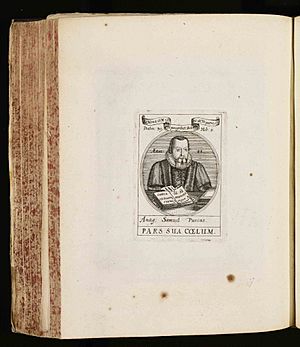
- Dick Turpin (1705–39): The famous highwayman was born nearby. While a cottage in Thaxted is named after him, there's no proof he lived there.
- Gustav Holst (1874–1934): The famous composer of The Planets lived in Thaxted. His home is marked with a blue plaque.
- Conrad Noel (1869–1942): Known as the town's 'Red Vicar', he was a Christian socialist and helped bring back morris dancing in Thaxted.
- Diana Wynne Jones: The author of Howl's Moving Castle grew up in Thaxted.
Places of Worship in Thaxted
The Church of Saint John the Baptist with Our Lady and Saint Laurence is the main Church of England parish church. It's a large medieval church that stands on a hilltop. In the 1900s, this church was central to the "Thaxted Movement," which combined traditional church practices with Christian Socialism.
Thaxted also has other churches:
- The United Reformed Church, built in 1876.
- The Baptist Church, in a building from 1832.
- A Roman Catholic Church was built in 1942.
Thaxted's Businesses and Shops
Thaxted's success used to come from making cutlery and wool. But by the 1600s, these trades declined. In 1870, a sweet factory opened in Thaxted, which became the town's biggest employer. This factory helped bring the light railway to town. The sweet factory closed in 1969.
Agriculture is still important to the local economy.
Thaxted has a good selection of shops, including a supermarket, a post office, a hardware store, and a bakery. There's also a petrol station. Thaxted has a weekly market on Fridays in Town Street, which was brought back in the 1990s.
Thaxted used to have many pubs, but most have closed. Today, three pubs remain in the town:
- The Swan Hotel: An old coaching inn.
- The Star: In a building from the 1300s.
- The Maypole.
Outside town, there's also the Farmhouse Inn in Monk Street.
Images for kids
-
The Manse where composer Gustav Holst lived from 1917 to 1925
-
Dick Turpin's cottage, suggesting the supposed association of the highwayman with Thaxted
See also
 In Spanish: Thaxted para niños
In Spanish: Thaxted para niños


